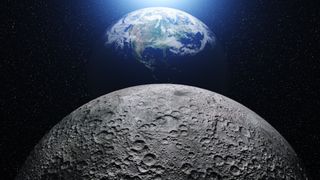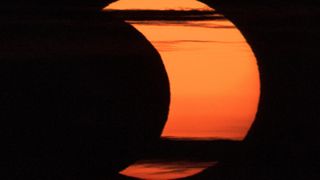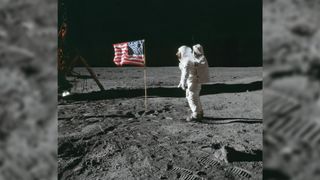How far is the moon from Earth?
Answering the question "how far is the moon from Earth?", can change depending on when you ask it.

It's the brightest object in our night sky, but how far is the moon from Earth?
The moon's distance from Earth affects the strength of ocean tides and the appearance of solar eclipses in our skies.
The average distance between the blue planet and its only natural satellite is about 238,855 miles (384,400 kilometers), according to NASA.
The moon does not orbit Earth in a perfect circle, so there are places along its trip when it is either closer or farther away from our planet than this average distance.
Shortest distance between the moon and Earth: Perigee
When the moon reaches its shortest distance to Earth — known as perigee — it is about 226,000 miles (363,300 km) away.
If perigee coincides with a full moon phase, this is generally called a supermoon. The term is not a scientific one, but it is used by the skywatching community when the full moon appears within 90% of perigee.
Supermoons appear roughly 17% bigger and 30% brighter than the faintest moon of the year. Since the moon's gravity exerts a pulling force on Earth's oceans to produce tides, the moon's closer proximity to Earth around perigee can also trigger higher-than-usual tides.
Greatest distance between the moon and Earth: Apogee
When the moon is at its farthest distance from Earth, known as apogee, it is about 251,000 miles (405,500 km) from our planet. One of the clearest natural visuals for apogee are annular, or "ring of fire," solar eclipses.
A remarkable quality of solar eclipses is the serendipity of their existence. For the next 600 million years, the moon's proximity to Earth will be about 400 times greater than the sun's distance to Earth. Since the star's diameter is also approximately 400 times greater than that of the moon, the disks of both objects tend to match almost perfectly during solar eclipses. This produces moments of totality when just the solar corona peeks out from behind the moon.
Related: Solar eclipses 2023: When, where & how to see them

But if the new moon phase that produces solar eclipses coincides with apogee, the moon's longer distance from Earth means that the lunar disk will appear much smaller in the sky. While still spectacular, annular solar eclipses do not completely block out the sun, Instead, they leave a ring of the solar disk visible to spectators.
How long does it take to get to the moon?
A range of factors determines how long it takes to reach the moon. Human missions, for instance, tend to take longer than passenger-free satellites. Whether or not an object stops at the moon or just zips by also comes into play.
The USSR launched the first mission to the moon, Luna 1, in 1959. With no propulsion system, the sphere-shaped satellite was hurled into space and took only 34 flight hours to make the trip. After its flyby, the satellite went into orbit around the sun, between the orbits of Earth and Mars. This remains one of the fastest trips to the moon.
In 2003, the European Space Agency launched SMART-1, the first successful European spacecraft to the moon. Rather than travel a direct path, SMART-1 spiraled around Earth to reach its satellite, arriving more than a year after launch. Instead of propellant, SMART-1 made the first use of an ion engine, in combination with gravity assist maneuvers, to reach the moon making it extremely fuel efficient. The extended path provided significant insight into the Earth-moon system
"Operating SMART-1 has been an extremely complex but rewarding task," Octavio Camino-Ramos, ESA SMART-1 Spacecraft Operations Manager said in a statement. "The long spiraling trajectory around Earth to test solar electric propulsion (a low-thrust approach), the long exposure to radiation, the strong perturbations of the gravity fields of the Earth-moon system and then the reaching of a lunar orbit optimized for the scientific investigations, have allowed us to gain valuable expertise in navigation techniques for low-thrust propulsion." He called the findings "a remarkable benchmark for the future."

NASA sent eight crewed Apollo missions to the moon, six of which landed successfully. (Apollo 8 was the first mission to orbit another body and Apollo 13's infamous disaster resulted in a journey around the moon rather than a landing on its surface.) Each spent about three days traveling through space.
Apollo 8 took 69 hours and 8 minutes to enter orbit around the moon. Apollo 11, which placed the first humans on the moon, took 75 hours and 56 minutes to enter orbit around the moon. Long before they entered orbit, however, both spacecraft entered the moon's sphere of influence, a region 33,823 nautical miles (62,630 km) from the moon. For Apollo 11, this occurred after 61 hours and 56 minutes, while for Apollo 8 it took only 55 hours 40 minutes.
But the quickest trip to the moon was the New Horizons probe, which zipped past the moon in just 8 hours 35 minutes. The spacecraft didn't even slow down or approach lunar orbit but instead flew by on its way to Pluto.
The moon is getting further away
The moon was once much closer to Earth. During the infancy of the solar system just as planets were finalizing their formation, a protoplanetary Earth collided with a Mars-sized object that may have formed farther away from the sun. Known as Theia, its impact produced the material that would eventually coalesce to form the moon.
The distance between the Earth and the moon grew as time passed. Currently, the moon drifts away from our planet at a rate of approximately 1.5 inches (3.8 cm) a year, roughly the same rate at which your fingernails grow!
Additional Resources
Explore the distance to the moon in more detail with this article from Royal Museums Greenwich. Learn how to measure the distance to the moon using a lunar eclipse or a parallax with this feature from Universe Today. Continue exploring moon to Earth distance measurements with the educational website Earth How.
If you're looking to take the best photos of the moon that you can, our how to photograph the moon guide is full of expert tips on techniques, times and tools to help you start taking the most impressive lunar photos you can. Our best cameras for astrophotography and best lenses for astrophotography can also help you take the best moon images you can, no matter your skill level.
Fancy taking a more in-depth moonlit tour of our rocky companion? Our ultimate guide to observing the moon will help you plan your next skywatching venture whether it be exploring the lunar seas, mountainous terrain, or the many craters that blanket the landscape. You can also see where astronauts, rovers and landers have ventured with our Apollo landing sites observing guide.
Bibliography
Ahrens, Caitlin. "Origin of the Moon, Impactor Theory." Encyclopedia of Lunar Science (2021).
Cano, Erick J., Zachary D. Sharp, and Charles K. Shearer. "Distinct oxygen isotope compositions of the Earth and Moon." Nature Geoscience 13.4 (2020): 270-274.
Jones, Andrea, et al. "Overview | Inside & Out – Moon: NASA Science." Public Engagement Team at NASA Goddard's Solar System Exploration Division. Accessed 31 January 2022.
Jones, Andrea, et al. "Eclipses | Moon in Motion." Public Engagement Team at NASA Goddard's Solar System Exploration Division. Accessed 31 January 2022.
Jones, Andrea, et al. "Supermoons | Moon in Motion." Public Engagement Team at NASA Goddard's Solar System Exploration Division. Accessed 31 January 2022.
Jones, Andrea, et al. "Moon Phases | Moon in Motion." Public Engagement Team at NASA Goddard's Solar System Exploration Division. Accessed 31 January 2022.
Join our Space Forums to keep talking space on the latest missions, night sky and more! And if you have a news tip, correction or comment, let us know at: community@space.com.
Get the Space.com Newsletter
Breaking space news, the latest updates on rocket launches, skywatching events and more!

Doris is a science journalist and Space.com contributor. She received a B.A. in Sociology and Communications at Fordham University in New York City. Her first work was published in collaboration with London Mining Network, where her love of science writing was born. Her passion for astronomy started as a kid when she helped her sister build a model solar system in the Bronx. She got her first shot at astronomy writing as a Space.com editorial intern and continues to write about all things cosmic for the website. Doris has also written about microscopic plant life for Scientific American’s website and about whale calls for their print magazine. She has also written about ancient humans for Inverse, with stories ranging from how to recreate Pompeii’s cuisine to how to map the Polynesian expansion through genomics. She currently shares her home with two rabbits. Follow her on twitter at @salazar_elin.